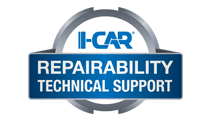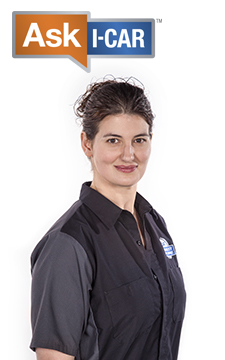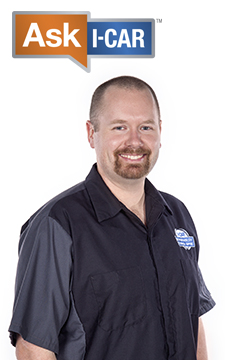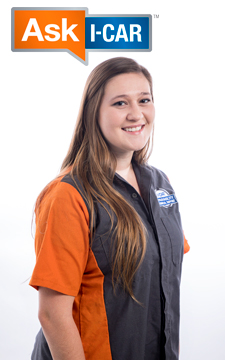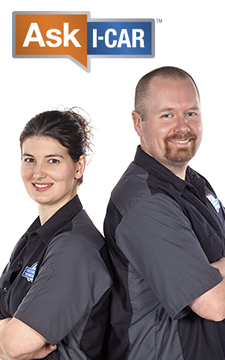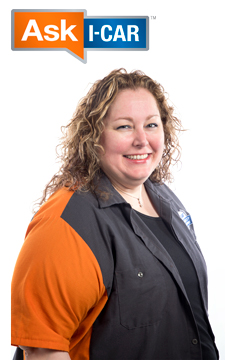Carbon Fiber Why Does It Matter?
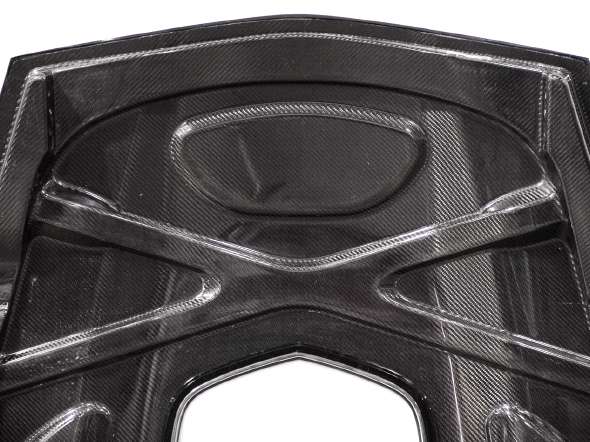 (Figure 1) A carbon fiber hood on a Chevrolet ZR1 Corvette.
(Figure 1) A carbon fiber hood on a Chevrolet ZR1 Corvette. Carbon fiber is being used on many late-model vehicles and has become a buzzword in the industry. This article answers some questions you may have been wondering about on the use and repair of carbon fiber.
Carbon fiber is only on high-end low production vehicles. I don't work on high-end vehicles. Why should I worry about carbon fiber?
While it is true that carbon fiber is only on high-end vehicles today, it doesn't mean that won't change in the very near future. Just take a minute to think back 15 years ago. Would you have ever thought that Ford would have an aluminum box and cab on a full-size pickup truck? Did you ever think that an everyday car like a Honda Accord would have steel rated at 1,500 MPa? Probably not. Back then, aluminum-intensive or UHSS structures would have only been on high-end low production vehicles. Yet in that short time span of 15 years, this is the current reality of the collision repair industry.
So now think of carbon fiber in that same context. Carbon fiber is relatively new to the automotive industry and is currently being used on high-end low production vehicles. If history were to repeat itself, as it often does, in a short time period the collision repair industry could be faced with repairs of everyday vehicles made of carbon fiber. At this point you can either wait until there's a vehicle sitting in a stall that no one has a clue how to repair or you can start the process of learning about this new material so you will be prepared for the not-to-distant future.
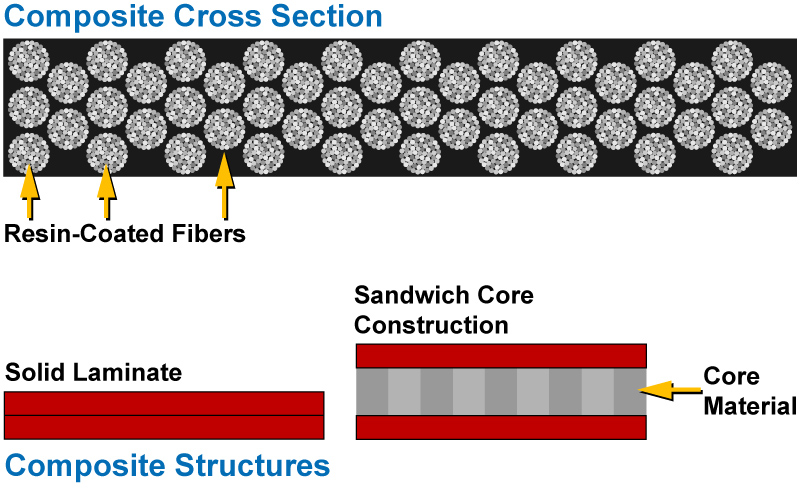 (Figure 2) This illustration shows the basics of a composite structure.
(Figure 2) This illustration shows the basics of a composite structure.
Where should we begin?
Let's start with what is carbon fiber? Carbon fiber is a man-made filament or fiber that has a high-carbon content. The carbon content is typically between 92 - 99% carbon, which is one of the reasons that carbon fiber has a grayish-black look. It is made into a variety of different cloths, weaves, or chopped fibers. There are also different weights and qualities of carbon fiber that can vary greatly and need to be chosen based upon the requirements of the part. The fibers are combined with a resin material to make parts. This resin might be vinyl, vinyl-ester, epoxy, or one of many other types of resin. Once the resins and fibers are cured, you have a composite part. In the end, carbon fiber is the buzzword for a specific kind of composite that has amazing possibilities now and into the future (see Figure 2).
Is carbon fiber just used for exterior panels?
Carbon fiber is not a material that will only be used for body and trim panels, it will often be used anywhere steel and aluminum are commonly used. Carbon fiber is being used to build the structure of the entire vehicle like the Lamborghini Aventador. The BMW i3 and i8 are going to have almost the entire passenger cell made of carbon fiber. With carbon fiber being used as structural parts, the industry will have to learn a whole new process of what it will take to repair the vehicle after the collision (see Figure 3).
Is carbon fiber repairable?
Carbon fiber is repairable depending on the damage. There are new tools and equipment, repair techniques, and areas of knowledge that will need to be applied to repair a carbon fiber part or structure. Some examples of tool and equipment that will be needed are tap testers, vacuum pumps, and hot bonders. Repair techniques will include accurate ply orientation and creating a scarfed (tapered) repair. If some of these terms are unfamiliar to you, it's understandable.
Watch an overview video on the vacuum bagging process.
Conclusion
The first step to meet the challenges that carbon fiber presents, is to begin to acquire knowledge about the material and what is involved in the repair process with this space age material. The industry will need to identify when to make the investment in tools, material, and training. It is not a question of if carbon fiber is going to appear in high production vehicles, but when it will appear.
Related I-CAR Courses
Article validated in 2024
-
Toyota/Lexus/Scion Position Statement: Pre- and Post-Repair System Scanning
Thursday, 28 July 2016
As the industry continues to ask if pre- and post-repair system scanning is necessary, Toyota/Lexus/Scion provides their answer.
-
Pre- and Post-Repair System Scanning Statements
Wednesday, 9 January 2019
Are you wondering if a particular OEM or organization has a published statement on pre-repair and post-repair scanning? We have compiled a list of most of the statements on the subject, so you can...
-
ADAS, Calibration, And Scanning Article Hotspot
Monday, 14 January 2019
Since advanced driver assistance systems (ADAS), scanning, and calibration first started becoming relevant, members of the collision repair industry have required as much knowledge as possible on...
-
Honda/Acura Position Statement: Pre- and Post-Repair System Scanning - UPDATE
Wednesday, 22 May 2019
Honda /Acura has updated their position statement on pre- and post-repair scanning to give more clarification on what is expected for scanning.
-
BMW Position Statement: Pre- and Post-Repair System Scanning - UPDATE
Friday, 10 April 2020
BMW has released a position statement related to pre- and post-repair system scanning. The statement applies to All vehicles equipped with on board diagnostics II (OBD II).
-
Quickly Identifying Outer Quarter Panels w/Rolled Hem Flanges
Monday, 5 March 2018
The I-CAR best practice article, Recycled Outer Quarter Panels w/Rolled Hem Flanges has gotten a lot of interest from the collision repair industry. It’s important to know which vehicles are...
-
General Motors Position Statement: Pre- and Post-Repair System Scanning
Friday, 21 October 2016
As the industry continues to ask, are pre- and post-repair scans necessary, General Motors provides their answer.
-
Restraints Wiring Repairs
Monday, 23 May 2016
Over the past few months, we've been sharing OEM position statements on restraints wiring repairs. Now we're bringing them all together in one place for easy reference.
-
FCA/Stellantis Position Statement: Pre- and Post-Repair System Scanning
Thursday, 9 June 2016
FCA/Stellantis has released a position statement related to pre- and post-repair system scanning.
-
Typical Calibration Requirements For Forward Radar Sensors
Wednesday, 12 October 2016
Technicians should be aware of what’s required to keep advanced driver assistance systems (ADAS) running safely after a collision. Whether that be aiming a camera, which can cause a system to not...
-
Jaguar Land Rover Mechanical, Electrical, And Trim (MET) Training
Friday, 31 October 2025
I-CAR now provides mechanical, electrical, and trim (MET) training for Jaguar Land Rover (JLR). This training is a new requirement for Jaguar Land Rover Authorized Collision Repair Centers.
-
I-CAR Repairers Realm: Spot Welding Machine Technology, Setup, And Maintenance - Now Available
Thursday, 30 October 2025
I-CAR had a discussion on spot welder machine technology, setup, and maintenance.
-
Back-To-Basics: Exterior Panel Fit-Up
Wednesday, 29 October 2025
Sometimes, going back to the basics can make the difference between a quality repair and a failed repair. Checking proper fit-up of exterior panels is vital for a successful repair when replacing...
-
I-CAR At SEMA 2025
Friday, 24 October 2025
Attending the SEMA Show in Las Vegas this year? Well, I-CAR will be providing many different opportunities to connect with you at this year’s show.
-
Ford On Target 2025: Volume 3
Thursday, 23 October 2025
Ford has released the third installment of their On Target publication for 2025.
-
OEM Emergency Response Guides: National Highway Traffic Safety Administration - UPDATE
Wednesday, 22 October 2025
Are you looking for OEM emergency response guides (ERGs)? The Repairability Technical Support (RTS) team has located these guides and either houses them on the RTS website, provides links to...
-
Ford/Lincoln Bumper Cover Repairability Position Statement: UPDATE
Thursday, 16 October 2025
Ford/Lincoln released updated position statements about repairing bumper covers on vehicles with advanced driver assistance systems (ADAS).
-
Bumper Cover Repair With ADAS: Ford/Lincoln - UPDATE
Thursday, 16 October 2025
A simple bumper repair on a modern vehicle may not be as simple as it seems. New technologies like blind spot monitoring, adaptive cruise control, and other advanced driver assistance systems (ADAS)...
-
I-CAR Mazda Collision Repair And Electromechanical Repair Overview Courses
Wednesday, 15 October 2025
I-CAR has developed courses that provide an overview of collision repair and electromechanical repair for current Mazda vehicles.
-
Back-To-Basics: Repair Vs. Replace Considerations
Friday, 10 October 2025
Sometimes, going back to the basics can make the difference between a quality repair and a failed repair. Deciding to repair or replace a damaged panel is a daily decision, but it is more...
- 2025
- October 2025 (13)
- September 2025 (11)
- August 2025 (12)
- July 2025 (11)
- June 2025 (11)
- May 2025 (11)
- April 2025 (13)
- March 2025 (12)
- February 2025 (11)
- January 2025 (12)
- 2024
- December 2024 (8)
- November 2024 (10)
- October 2024 (13)
- September 2024 (10)
- August 2024 (12)
- July 2024 (11)
- June 2024 (9)
- May 2024 (13)
- April 2024 (12)
- March 2024 (12)
- February 2024 (12)
- January 2024 (9)
- 2023
- December 2023 (8)
- November 2023 (12)
- October 2023 (11)
- September 2023 (11)
- August 2023 (12)
- July 2023 (9)
- June 2023 (11)
- May 2023 (12)
- April 2023 (11)
- March 2023 (12)
- February 2023 (10)
- January 2023 (11)
- 2022
- December 2022 (11)
- November 2022 (12)
- October 2022 (11)
- September 2022 (13)
- August 2022 (11)
- July 2022 (10)
- June 2022 (13)
- May 2022 (11)
- April 2022 (12)
- March 2022 (10)
- February 2022 (11)
- January 2022 (13)
- 2021
- December 2021 (13)
- November 2021 (11)
- October 2021 (13)
- September 2021 (14)
- August 2021 (12)
- July 2021 (15)
- June 2021 (17)
- May 2021 (12)
- April 2021 (14)
- March 2021 (20)
- February 2021 (14)
- January 2021 (14)
- 2020
- December 2020 (13)
- November 2020 (17)
- October 2020 (12)
- September 2020 (14)
- August 2020 (11)
- July 2020 (18)
- June 2020 (15)
- May 2020 (14)
- April 2020 (20)
- March 2020 (12)
- February 2020 (13)
- January 2020 (14)
- 2019
- December 2019 (13)
- November 2019 (19)
- October 2019 (25)
- September 2019 (20)
- August 2019 (22)
- July 2019 (23)
- June 2019 (20)
- May 2019 (19)
- April 2019 (20)
- March 2019 (20)
- February 2019 (18)
- January 2019 (18)
- 2018
- December 2018 (18)
- November 2018 (19)
- October 2018 (17)
- September 2018 (16)
- August 2018 (21)
- July 2018 (20)
- June 2018 (21)
- May 2018 (17)
- April 2018 (19)
- March 2018 (21)
- February 2018 (15)
- January 2018 (20)
- 2017
- December 2017 (13)
- November 2017 (15)
- October 2017 (19)
- September 2017 (20)
- August 2017 (19)
- July 2017 (18)
- June 2017 (19)
- May 2017 (19)
- April 2017 (13)
- March 2017 (18)
- February 2017 (10)
- January 2017 (11)
- 2016
- December 2016 (9)
- November 2016 (14)
- October 2016 (21)
- September 2016 (10)
- August 2016 (11)
- July 2016 (8)
- June 2016 (10)
- May 2016 (5)
- April 2016 (11)
- March 2016 (12)
- February 2016 (10)
- January 2016 (8)
- 2015
- December 2015 (9)
- November 2015 (6)
- October 2015 (8)
- September 2015 (7)
- August 2015 (11)
- July 2015 (7)
- June 2015 (5)
- May 2015 (7)
- April 2015 (8)
- March 2015 (8)
- February 2015 (9)
- January 2015 (10)
- 2014
- December 2014 (12)
- November 2014 (7)
- October 2014 (11)
- September 2014 (10)
- August 2014 (9)
- July 2014 (12)
- June 2014 (9)
- May 2014 (12)
- April 2014 (9)
- March 2014 (6)
- February 2014 (1)
- January 2014 (26)
